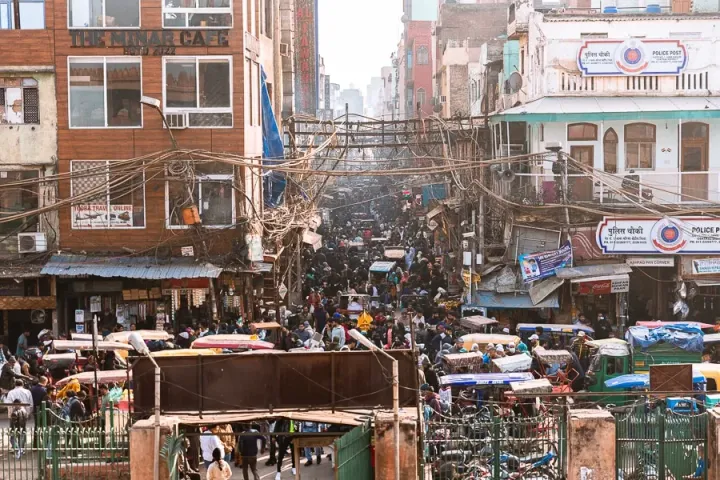Tassels, Trinkets, and Traditions: Inside Kinari Bazaar

Kinari Bazaar: A Tapestry of Tradition and Trade
The name "Kinari Bazaar" is derived from the Hindi word "kinari," which means "border" or "edge." True to its name, the market is renowned for its extensive collection of decorative borders, laces, fringes, and trims used in traditional Indian garments and accessories. These ornate embellishments play a crucial role in Indian weddings and festive attire, making Kinari Bazaar a go-to destination for anyone looking to add a touch of opulence to their outfits.
Seeped in Rich History
Kinari Bazaar's origins can be traced back to the Mughal era, when Chandni Chowk was established by Emperor Shah Jahan in the 17th century. Chandni Chowk was designed as a grand marketplace, and Kinari Bazaar quickly became a hub for traders and artisans specializing in intricate embroidery and embellishments. The market's strategic location near the Red Fort and Jama Masjid ensured a steady flow of customers, including royalty and nobility seeking luxurious fabrics and accessories.
During the Mughal period, Kinari Bazaar thrived as a center of textile trade. Skilled artisans from across the region flocked to the market, bringing with them a wealth of knowledge and techniques passed down through generations. The market's proximity to the royal courts further elevated its status, as members of the Mughal elite sought out the finest fabrics and embellishments for their garments.
Architectural Charm of Kinari Bazaar
Walking through Kinari Bazaar is like stepping back in time. The narrow, winding lanes are lined with shops that have retained their traditional facades, complete with ornate wooden doors and intricate carvings. Many of the buildings date back to the Mughal era, showcasing a blend of Mughal and Rajasthani architectural styles. The vibrant colors and elaborate designs of the shopfronts add to the market's enchanting atmosphere.
One of the most striking features of Kinari Bazaar is its labyrinthine layout. The narrow lanes and alleys create an intimate and immersive experience, allowing visitors to explore the market at their own pace. The buildings, with their arched doorways and decorative balconies, provide a glimpse into the architectural grandeur of a bygone era. The market's timeless charm is further enhanced by the hustle and bustle of daily trade, as shopkeepers display their wares and customers haggle for the best deals.
Exploring Kinari Bazaar in Chandni Chowk
Kinari Bazaar is a significant attraction for tourists visiting Delhi, offering a unique blend of history, culture, and shopping. The market's specialty in wedding accessories makes it particularly popular among those looking to experience Indian wedding traditions firsthand. From intricate zardozi work to shimmering sequins, the craftsmanship on display is a testament to India's rich textile heritage.
For international tourists, a visit to Kinari Bazaar provides an opportunity to immerse themselves in the vibrant culture of Delhi's local bazaars. The market's lively atmosphere, coupled with its historical significance, makes it a must-visit destination for those seeking an authentic experience. Whether you're shopping for souvenirs, exploring the architectural marvels, or simply soaking in the ambiance, Kinari Bazaar offers something for everyone.
Festival Decorations at Kinari Bazaar
Kinari Bazaar truly comes alive during India's numerous festivals. It serves as the nerve centre for sourcing decorative items for major festivals like Diwali and Janmashtami. Rangoli (floor art) stencils, decorative diyas (lamps), torans (door hangings), and idols; you name it, Kinari Bazaar has it! These intricately designed adornments are not just mere decorations but embody deep-rooted religious beliefs and traditions.
Jewelry Market at Kinari Bazaar
Jewelry plays an important role in Indian culture, adding a sparkle to every occasion. The flea-market-like charm of this local bazaar makes it a sought-after destination for affordable silver jewelry. From detailed jhumkees (bell-shaped earrings) to ghunghroo laden payals (anklets with small metallic bells), the variety is endless. Each piece carries cultural significance in Indian traditions, often worn during festivals, weddings, and other ceremonies.
How to Get There
Kinari Bazaar is located in the heart of Old Delhi, making it easily accessible from various parts of the city. Here’s how you can get there:
- By Metro: The nearest metro station is Chandni Chowk (Yellow Line). From there, it's a short rickshaw ride or a 10-minute walk to Kinari Bazaar. The metro is a convenient and efficient way to navigate Delhi's bustling streets, and the Chandni Chowk station is well-connected to other parts of the city.
- By Rickshaw: Cycle rickshaws and auto-rickshaws are abundant in Chandni Chowk. They provide a traditional and economical mode of transport, allowing you to navigate the narrow lanes and busy streets with ease. Simply ask the driver to take you to Kinari Bazaar, and they'll drop you off right at the market's entrance.
- By Taxi: Taxis and ride-hailing services like Uber and Ola are also available. While they offer a more comfortable and direct route, be prepared for potential traffic jams, especially during peak hours. It's advisable to book your ride in advance to avoid any delays.
- On Foot: If you're staying nearby or want to experience the vibrant street life of Chandni Chowk, walking is a great option. The market is a short walk from popular landmarks like the Red Fort and Jama Masjid. Walking allows you to explore the area at your own pace, taking in the sights, sounds, and smells of one of Delhi's oldest neighborhoods.
Timings and Entry Information
Kinari Bazaar is a public market, and there is no entry fee. This Delhi shopping area is open from Monday to Saturday. Most shops open around 10:00 am and close by 8:00 pm. Visiting during weekdays can be less crowded compared to weekends, giving you more space to explore and shop.
Since Kinari Bazaar is part of Chandni Chowk, it's advisable to combine your visit with other nearby attractions. This allows you to make the most of your time in the area and experience the rich cultural heritage of Old Delhi. Additionally, many shops in Kinari Bazaar offer bulk discounts, so don't hesitate to negotiate if you're buying in larger quantities.
Kinari Bazaar and Chandni Chowk: What to Expect
While Kinari Bazaar is a historical market with limited modern facilities, the surrounding area of Chandni Chowk is well-equipped to cater to tourists. It is perfect for those who want to indulge in an authentic Delhi shopping and tourism experience at local bazaars.
- Food and Drink: Chandni Chowk is famous for its street food. From spicy chaats to sweet jalebis, there’s something for every palate. There are also several restaurants and cafes where you can enjoy a sit-down meal. Some popular eateries include Karim's, known for its Mughlai cuisine, and Haldiram's, offering a wide variety of Indian snacks and sweets.
- Shopping: The markets around Kinari Bazaar are filled with shops selling textiles, jewelry, spices, and handicrafts. It’s a great place to buy unique gifts and souvenirs. Chandni Chowk's bustling markets offer everything from traditional Indian attire to modern gadgets, making it a shopper's paradise.
- Restrooms: Public restrooms are available in the larger marketplaces and near major attractions like the Red Fort and Jama Masjid. Many restaurants and cafes also have clean restroom facilities for their customers.
- Guides and Tours: If you prefer a guided experience, there are several tour operators offering walking tours of Chandni Chowk, including Kinari Bazaar. These tours provide historical context and interesting anecdotes that enrich your visit. Some tours also include food tastings and visits to lesser-known spots in the local bazaars.
- Transportation: The area is well-served by rickshaws, taxis, and metro stations, making it easy to get around. Public transport is affordable and convenient, allowing you to explore different parts of Delhi without hassle.
Practical Tips for Travellers
Here are some practical tips to help you make the most of your visit to Kinari Bazaar:
- Dress Comfortably: Wear comfortable shoes and light clothing, as you’ll be walking through narrow lanes and crowded markets. The weather in Delhi can be hot, especially during summer, so dress accordingly.
- Stay Hydrated: Carry a bottle of water to stay hydrated, especially if you’re visiting during the warmer months. It's also a good idea to bring a hat or umbrella for sun protection.
- Bargain Wisely: Bargaining is common in Indian markets. Don’t hesitate to negotiate prices, but do so politely and with a smile. Start by offering about half the quoted price and work your way up from there.
- Keep Valuables Safe: Be mindful of your belongings and keep your valuables secure. Use a money belt or a secure bag to carry your essentials. The crowded markets can be a target for pickpockets, so it's important to stay vigilant.
- Explore Beyond Shopping: While shopping is a highlight, take time to soak in the ambiance, admire the architecture, and interact with the locals. Don’t miss the opportunity to sample the local street food. Be adventurous but cautious; opt for popular and busy stalls to ensure food safety.
- Plan Your Visit: If possible, visit during weekdays to avoid the weekend crowds. Early mornings or late afternoons are the best times to explore the market. Planning your visit allows you to enjoy a more relaxed and enjoyable experience.
- Take Guided Tours: Consider joining a guided tour to gain deeper insights into the market’s history and culture. Guided tours often include interesting anecdotes and historical facts that you might miss on your own.
Key Attractions Nearby
While Kinari Bazaar is a captivating destination on its own, there are several nearby attractions that you shouldn’t miss:
- Red Fort: A UNESCO World Heritage Site, the Red Fort is a magnificent example of Mughal architecture and a symbol of India’s rich history. The fort's massive red sandstone walls, intricate carvings, and lush gardens make it a must-visit landmark. The fort also hosts a light and sound show in the evenings, narrating the history of Delhi in an engaging manner.
- Jama Masjid: One of the largest mosques in India, Jama Masjid is an architectural marvel and offers a panoramic view of Delhi from its minarets. Built by Shah Jahan, the mosque features grand domes, towering minarets, and a vast courtyard that can accommodate thousands of worshippers. Climbing the southern minaret is a must for a breathtaking view of Old Delhi.
- Gurudwara Sis Ganj Sahib: A significant Sikh shrine, Gurudwara Sis Ganj Sahib marks the site where the ninth Sikh Guru, Guru Tegh Bahadur, was martyred. The gurudwara is a place of worship and community service, offering free meals to all visitors in its langar (community kitchen). The serene atmosphere and spiritual significance make it a worthwhile visit.
- Khari Baoli: Asia’s largest spice market, Khari Baoli is a sensory overload with its vibrant colors and strong aromas. Here, you can find a wide variety of spices, dried fruits, nuts, and herbs. It's a fantastic place to learn about Indian spices and pick up some authentic ingredients for your kitchen.
- Dariba Kalan: Known for its silver jewelry, Dariba Kalan is a historic jewelry market that dates back to the Mughal era. The narrow lanes are lined with shops selling exquisite silver and gold jewelry, gemstones, and traditional Indian ornaments. It's a great place to buy unique and handcrafted pieces.
The Timeless Charm of Kinari Bazaar: A Must-Visit Destination
Kinari Bazaar in Chandni Chowk is more than just a market; it’s a living testament to Delhi’s rich cultural and historical tapestry. From its origins in the Mughal era to its role in contemporary Delhi tourism, Kinari Bazaar offers international tourists a unique blend of tradition, craftsmanship, and vibrant local life.
Whether you’re shopping for exquisite trims and laces, exploring nearby historical landmarks, or simply soaking in the market’s lively atmosphere, Kinari Bazaar promises an unforgettable experience. So, the next time you find yourself in Delhi, make sure to carve out some time to explore this market and discover the myriad treasures it holds.




Comments ()